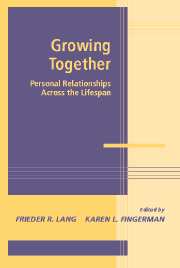Book contents
- Frontmatter
- Contents
- Contributors
- Acknowledgments
- 1 Coming Together: A Perspective on Relationships across the Life Span
- 2 Relationships as Outcomes and Contexts
- 3 Child-Parent Relationships
- 4 A Dynamic Ecological Systems Perspective on Emotion Regulation Development within the Sibling Relationship Context
- 5 Romantic and Marital Relationships
- 6 Close Relationships across the Life Span: Toward a Theory of Relationship Types
- 7 Friendship across the Life Span: Reciprocity in Individual and Relationship Development
- 8 The Consequential Stranger: Peripheral Relationships across the Life Span
- 9 Stress in Social Relationships: Coping and Adaptation across the Life Span
- 10 Social Support and Physical Health across the Life Span: Socioemotional Influences
- 11 Social Cognition and Social Relationships
- 12 Dyadic Fits and Transactions in Personality and Relationships
- 13 Relational Competence across the Life Span
- 14 Social Motivation across the Life Span
- 15 A Lifetime of Relationships Mediated by Technology
- Subject Index
- Author Index
- References
1 - Coming Together: A Perspective on Relationships across the Life Span
Published online by Cambridge University Press: 02 September 2009
- Frontmatter
- Contents
- Contributors
- Acknowledgments
- 1 Coming Together: A Perspective on Relationships across the Life Span
- 2 Relationships as Outcomes and Contexts
- 3 Child-Parent Relationships
- 4 A Dynamic Ecological Systems Perspective on Emotion Regulation Development within the Sibling Relationship Context
- 5 Romantic and Marital Relationships
- 6 Close Relationships across the Life Span: Toward a Theory of Relationship Types
- 7 Friendship across the Life Span: Reciprocity in Individual and Relationship Development
- 8 The Consequential Stranger: Peripheral Relationships across the Life Span
- 9 Stress in Social Relationships: Coping and Adaptation across the Life Span
- 10 Social Support and Physical Health across the Life Span: Socioemotional Influences
- 11 Social Cognition and Social Relationships
- 12 Dyadic Fits and Transactions in Personality and Relationships
- 13 Relational Competence across the Life Span
- 14 Social Motivation across the Life Span
- 15 A Lifetime of Relationships Mediated by Technology
- Subject Index
- Author Index
- References
Summary
This chapter introduces a life-span perspective on personal relationships by emphasizing how the structure, processes, and outcomes of relationships are interwoven with human development. The social arena serves as a metaphor for changes and continuities individuals experience in their social partners, activities, and goals over the life span. We consider mutual influences between individual development and relationship partners, including 1) individual changes, 2) the development of relationships themselves, and 3) the context of the larger social network. A life-span understanding of personal relationships considers the structure of relationships (e.g., the types of social partners individuals of different ages interact with), the processes underlying personal relationships (e.g., personality, motivation for social contact, cognition), and the outcomes or precursors of relationship change across the life span.
We, the editors of this book, are parents of young children. As a result, when the weather allows it, we spend considerable time at our local parks and frequently have the opportunity to observe a microcosm of life-span relationships. People of all ages engage in activities, from sitting under a tree watching the clouds, to playing softball in mixed groups of adults and children. Our little ones vie for attention among the other children who run around the slide or swings. Older children throw balls or participate in organized activities. A group of teenagers sit apart and listen to music on a portable compact disc player. Multiple generations come together for a family picnic. Young couples hold hands as they stroll.
- Type
- Chapter
- Information
- Growing TogetherPersonal Relationships Across the Life Span, pp. 1 - 23Publisher: Cambridge University PressPrint publication year: 2003
References
- 1
- Cited by



